牛津译林版(2019)必修第二册 Unit 2 Be sporty, be healthy-Reading 2教学课件(共19张PPT)
文档属性
| 名称 | 牛津译林版(2019)必修第二册 Unit 2 Be sporty, be healthy-Reading 2教学课件(共19张PPT) |  | |
| 格式 | ppt | ||
| 文件大小 | 1.4MB | ||
| 资源类型 | 教案 | ||
| 版本资源 | 牛津译林版(2019) | ||
| 科目 | 英语 | ||
| 更新时间 | 2022-09-22 19:33:36 | ||
图片预览

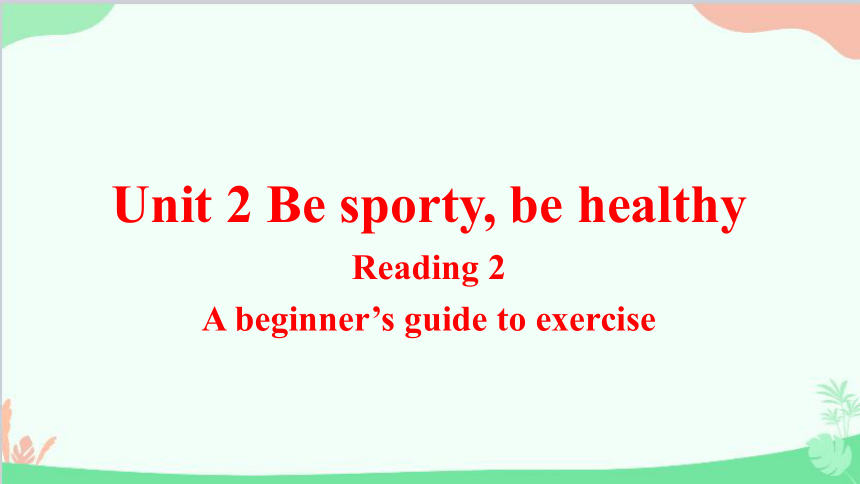
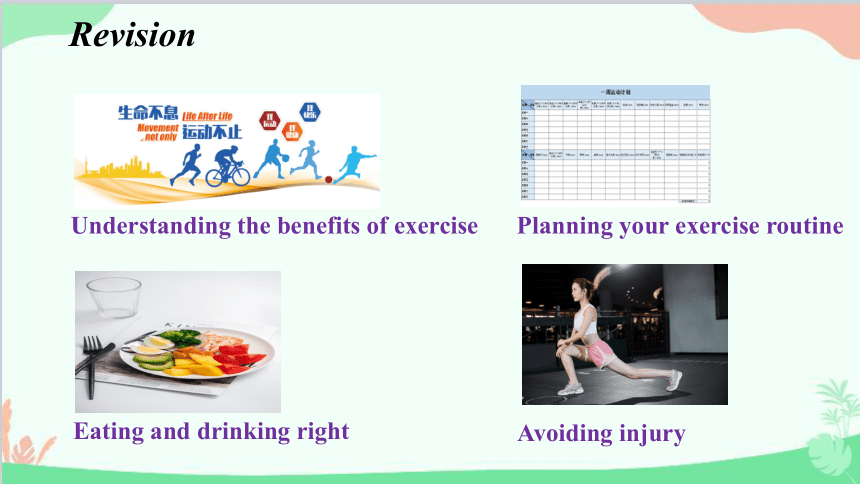
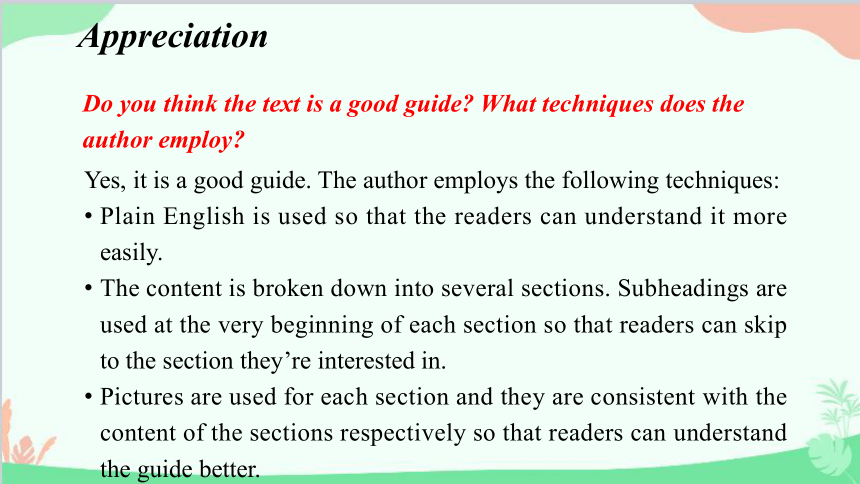
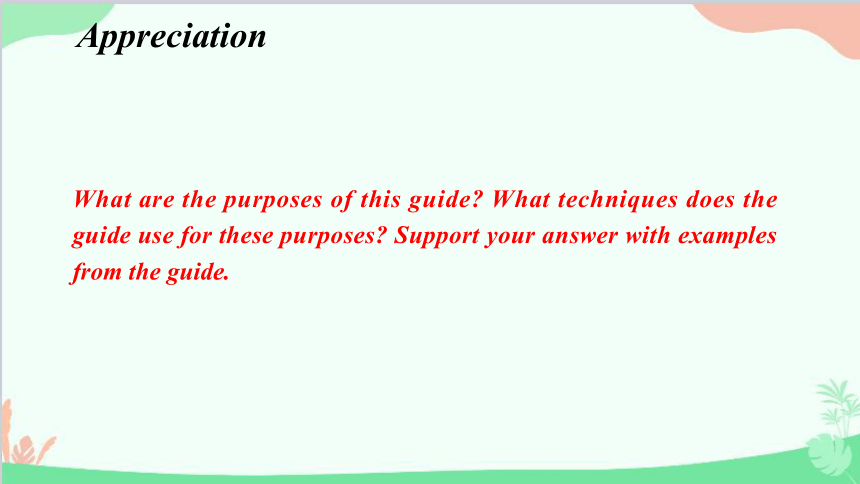

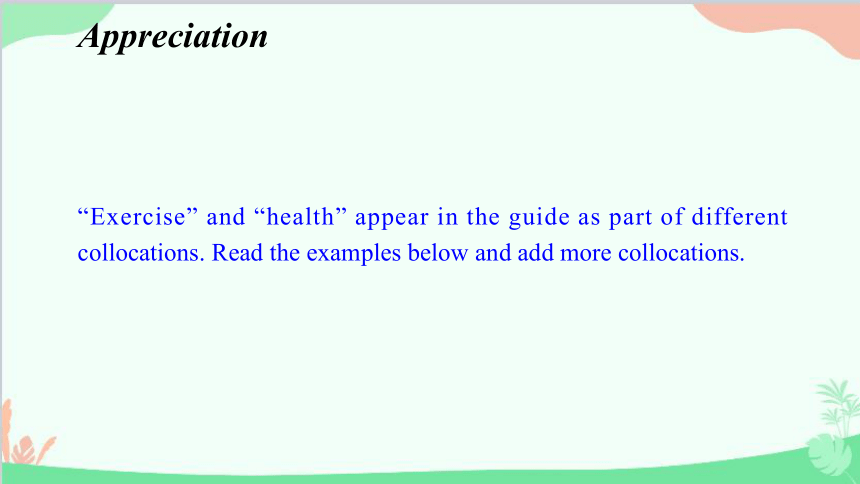
文档简介
(共19张PPT)
Unit 1
Reading 1
The evolution of video and sound devices
高中英语 必修(第二册)
Unit 2 Be sporty, be healthy
Reading 2
A beginner’s guide to exercise
Revision
Planning your exercise routine
Eating and drinking right
Avoiding injury
Understanding the benefits of exercise
Appreciation
Do you think the text is a good guide What techniques does the author employ
Yes, it is a good guide. The author employs the following techniques:
Plain English is used so that the readers can understand it more easily.
The content is broken down into several sections. Subheadings are used at the very beginning of each section so that readers can skip to the section they’re interested in.
Pictures are used for each section and they are consistent with the content of the sections respectively so that readers can understand the guide better.
What are the purposes of this guide What techniques does the guide use for these purposes Support your answer with examples from the guide.
Appreciation
The purposes of the guide are to encourage readers to exercise and to inform them of the proper way of exercising. The guide asks questions at the beginning and at the end to give encouragement. In lines 16–21, it gives examples to explain how different types of exercise improve our health. In lines 25–26, it compares the human body to a car that needs to be fuelled to help the reader understand the role of carbohydrates. These techniques are very effective in presenting information.
Appreciation
“Exercise” and “health” appear in the guide as part of different collocations. Read the examples below and add more collocations.
Appreciation
aerobic exercise, physical exercise,
daily exercise
take exercise, get exercise
an exercise guide, an exercise bike,
an exercise programme
physical health, poor health, good
health, public health
risk health, damage health
health risks, health care, health systems, health workers, health services, health education, health centres, health problems
Appreciation
Using different collocations.
Like cars that run on petrol, your body burns carbohydrates for energy.
What rhetorical device is used in this sentence Why is this sentence better than “Your body needs carbohydrates to provide you with energy”
The author uses “simile”, in which body is compared to cars and carbohydrates are compared to petrol. Body and cars have some characteristics in common, and so do carbohydrates and petrol. For example, both body and cars need to burn something for energy. When a simile is used, a concept is easier to understand.
Simile
Appreciation
Cautious language is used to avoid overgeneralizing. Pay attention to the following words and phrases:
Modal verbs: can, could, may, might, should, would
Verbs and verb phrases: appear, look like, seem, tend to
Adverbs and adverbial phrases: probably, usually, sometimes, mainly, in general
Adjectives: likely, possible, probable, unlikely
Read and find the sentences using cautious language in the guide.
Cautious language
Appreciation
Active people tend to have better immune systems and are at lower risk of diseases.
Working out can help you reduce stress and get over negative feelings.
Above all, choose activities you enjoy because, in this way, you’re more likely to stick with them.
In general, you should have your meal an average of 1.5 to 2.5 hours before exercising.
You should also start small and slowly work your way to a longer and harder exercise routine to avoid getting hurt.
Appreciation
Revise the sentences below using cautious language.
People do not like getting up early for morning exercise in cold weather. They want to get as much sleep as they can. However, truly healthy people get their workout done anyway. They know they will feel great afterwards.
Generally speaking, people do not like getting up early for morning exercise in cold weather. They usually want to get as much sleep as they can. However, truly healthy people probably get their workout done anyway. They know they will most likely feel great afterwards.
Application
As for exercise, more is always better.
Do you agree Why or why not
Exploration
Exercise has a range of health benefits. However, some people (1) _______ that if some exercise is good, more is always better, so they (2) ______ exercise for a long time without stopping. For example, some people go (3) _______ for several hours at a time because of the step-counting smartphone apps. Others work out for hours at the weekend (4) _____________ their lack of exercise during the weekdays. Habits like these put stress on the body, and if they are maintained (5) ________________, can become a serious health risk.
moreover assume average over the long term
Jogging prevent tend to make up for
assume
tend to
jogging
to make up for
over the long term
Exploration
Generally speaking, aerobic routines that last over 100 minutes have a certain health risk. On the other hand, they should not be shorter than 10 minutes. If you do exercise for only a few minutes, you may not be working out long enough to see any benefits from it. When you exercise, aim for the daily (6) ________ of 30 to 60 minutes. This will (7) ________ you from getting hurt. (8) _________, it will ensure that the exercise you do has a positive effect on your physical health.
moreover assume average over the long term
Jogging prevent tend to make up for
average
prevent
Moreover
Exploration
What do you think of the idea about exercise mentioned in B1—more is always better Reflect on your exercise habits.
I love basketball very much. And I usually play basketball with my classmates the whole afternoon every Saturday. Now I know it does great harm to my health, as such an intense workout will put great pressure on my body. I plan to play basketball every other day, and each time for 40 minutes.
Discussion
1. Put down your opinions on your exercise book with the title: Is more always better
2. Finish A and B on Page 63 in the workbook.
Homework
Homework
1. Read this article aloud.
2. Finish the workbook.
谢 谢
Unit 1
Reading 1
The evolution of video and sound devices
高中英语 必修(第二册)
Unit 2 Be sporty, be healthy
Reading 2
A beginner’s guide to exercise
Revision
Planning your exercise routine
Eating and drinking right
Avoiding injury
Understanding the benefits of exercise
Appreciation
Do you think the text is a good guide What techniques does the author employ
Yes, it is a good guide. The author employs the following techniques:
Plain English is used so that the readers can understand it more easily.
The content is broken down into several sections. Subheadings are used at the very beginning of each section so that readers can skip to the section they’re interested in.
Pictures are used for each section and they are consistent with the content of the sections respectively so that readers can understand the guide better.
What are the purposes of this guide What techniques does the guide use for these purposes Support your answer with examples from the guide.
Appreciation
The purposes of the guide are to encourage readers to exercise and to inform them of the proper way of exercising. The guide asks questions at the beginning and at the end to give encouragement. In lines 16–21, it gives examples to explain how different types of exercise improve our health. In lines 25–26, it compares the human body to a car that needs to be fuelled to help the reader understand the role of carbohydrates. These techniques are very effective in presenting information.
Appreciation
“Exercise” and “health” appear in the guide as part of different collocations. Read the examples below and add more collocations.
Appreciation
aerobic exercise, physical exercise,
daily exercise
take exercise, get exercise
an exercise guide, an exercise bike,
an exercise programme
physical health, poor health, good
health, public health
risk health, damage health
health risks, health care, health systems, health workers, health services, health education, health centres, health problems
Appreciation
Using different collocations.
Like cars that run on petrol, your body burns carbohydrates for energy.
What rhetorical device is used in this sentence Why is this sentence better than “Your body needs carbohydrates to provide you with energy”
The author uses “simile”, in which body is compared to cars and carbohydrates are compared to petrol. Body and cars have some characteristics in common, and so do carbohydrates and petrol. For example, both body and cars need to burn something for energy. When a simile is used, a concept is easier to understand.
Simile
Appreciation
Cautious language is used to avoid overgeneralizing. Pay attention to the following words and phrases:
Modal verbs: can, could, may, might, should, would
Verbs and verb phrases: appear, look like, seem, tend to
Adverbs and adverbial phrases: probably, usually, sometimes, mainly, in general
Adjectives: likely, possible, probable, unlikely
Read and find the sentences using cautious language in the guide.
Cautious language
Appreciation
Active people tend to have better immune systems and are at lower risk of diseases.
Working out can help you reduce stress and get over negative feelings.
Above all, choose activities you enjoy because, in this way, you’re more likely to stick with them.
In general, you should have your meal an average of 1.5 to 2.5 hours before exercising.
You should also start small and slowly work your way to a longer and harder exercise routine to avoid getting hurt.
Appreciation
Revise the sentences below using cautious language.
People do not like getting up early for morning exercise in cold weather. They want to get as much sleep as they can. However, truly healthy people get their workout done anyway. They know they will feel great afterwards.
Generally speaking, people do not like getting up early for morning exercise in cold weather. They usually want to get as much sleep as they can. However, truly healthy people probably get their workout done anyway. They know they will most likely feel great afterwards.
Application
As for exercise, more is always better.
Do you agree Why or why not
Exploration
Exercise has a range of health benefits. However, some people (1) _______ that if some exercise is good, more is always better, so they (2) ______ exercise for a long time without stopping. For example, some people go (3) _______ for several hours at a time because of the step-counting smartphone apps. Others work out for hours at the weekend (4) _____________ their lack of exercise during the weekdays. Habits like these put stress on the body, and if they are maintained (5) ________________, can become a serious health risk.
moreover assume average over the long term
Jogging prevent tend to make up for
assume
tend to
jogging
to make up for
over the long term
Exploration
Generally speaking, aerobic routines that last over 100 minutes have a certain health risk. On the other hand, they should not be shorter than 10 minutes. If you do exercise for only a few minutes, you may not be working out long enough to see any benefits from it. When you exercise, aim for the daily (6) ________ of 30 to 60 minutes. This will (7) ________ you from getting hurt. (8) _________, it will ensure that the exercise you do has a positive effect on your physical health.
moreover assume average over the long term
Jogging prevent tend to make up for
average
prevent
Moreover
Exploration
What do you think of the idea about exercise mentioned in B1—more is always better Reflect on your exercise habits.
I love basketball very much. And I usually play basketball with my classmates the whole afternoon every Saturday. Now I know it does great harm to my health, as such an intense workout will put great pressure on my body. I plan to play basketball every other day, and each time for 40 minutes.
Discussion
1. Put down your opinions on your exercise book with the title: Is more always better
2. Finish A and B on Page 63 in the workbook.
Homework
Homework
1. Read this article aloud.
2. Finish the workbook.
谢 谢
